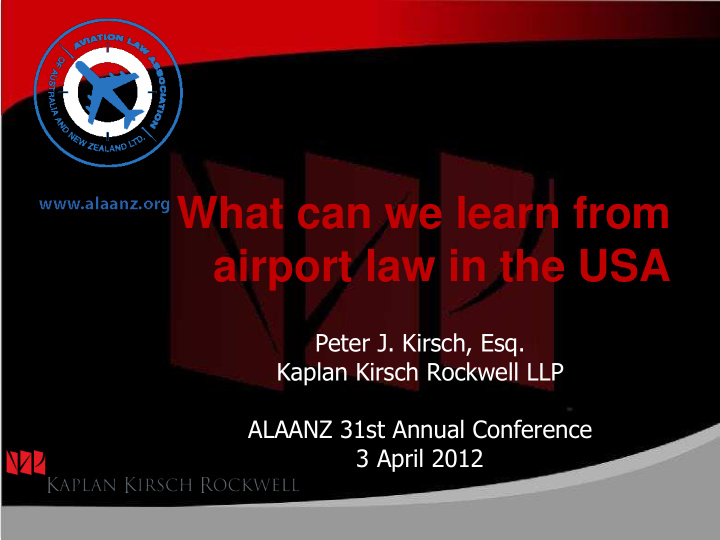



What can we learn from airport law in the USA Peter J. Kirsch, Esq. Kaplan Kirsch Rockwell LLP ALAANZ 31st Annual Conference 3 April 2012
This morning’s presentation • Introduction to aviation regulatory scheme in the USA – focus on airports • Challenges posed by split authority • Sources of FAA legal authority • Hot topics in airport law in USA 2
Inherent statutory tension • Federal Aviation Administration is an all-in- one agency charged with: – Promoting aviation, air commerce – Regulating aviation, air commerce – Operating air traffic control system – Ensuring safety of the entire system 3
Who the FAA regulates Pilots Airports Aircraft Aircraft Operators
How the FAA operates FUNDS & REGULATES Airports CERTIFIES OPERATES Aircraft Air Traffic LICENSES Pilots 5
Dealing with the FAA 6
Silos - lines of business Secretary of Transportation Administrator of FAA NextGen Aviation and Commercial Airports Air Traffic Safety Operations Space Planning Staff Offices 7
Unique features of FAA • Operator (air traffic system) • Certification and regulation authority (pilots, aircraft manufacturing) • Safety regulator • Funder (airport capital improvements) • Overseer of financial arrangements but limited role in business of aviation • US model leads to considerable international confusion – ICAO, IATA, CAEP, EU don’t fully appreciate limited federal authority (and intensely local authority over airports) 8
Required cooperation • Operation of national aviation system is a “cooperative scheme” – FAA (aircraft and airspace) – Airports (ground operations; airport operations) – Operators (private sector) • Much cooperation defined by case law – Jurisprudence has evolved in the last 100 years; few bright lines • Legal foundation: federal preemption 9
FAA responsibilities EXCLUSIVE - FAA SHARED Use of airspace Airport operations Aircraft certification Aircraft operations Pilot certification and Noise abatement, regulation mitigation Aircraft noise Financial matters Aircraft safety Airfield safety Financial accountability Funding 10
Principles of preemption • Federal preemption is a continuum – Aircraft and flight (use of airspace) at one end – Non-operational, land-side airport matters at the other • Source of preemption – Use of airspace – Federal aviation statutes • Express, implied and conflict preemption • Different for each FAA function – Congress has preserved “proprietary powers and rights” of airport operators ( not police powers) 11
Airports 12
FAA role - airports • Federal role with respect to airports derives primarily from power of the purse – Discretionary and entitlement funds • FAA gives money and regulates and authorizes airport taxes, use of revenue • Regulation tied to money • FAA wants to give airports money – Inherent in agency mission to promote aviation – Source of influence over airport decisions • Inherent (and deliberate) tension 13
Partnership – airports and FAA Adjudicator Inspector Funder Regulator Airport Advocate Proprietor 14
Three major sources of authority • Grant Assurances – Receipt of federal grants – 20-year duration in most instances • Deeds – Principally Surplus Property Act deeds (WW II surplus) • Part 139 – Commercial service airports only – Airport operating certificate (AOC) 15
Some regulation depends on type of airport • General aviation vs. commercial service – Substantially different role – Source of authority is different 16
FAA as regulator 17
FAA as regulator • While FAA role in airports is complex, other roles are far clearer: FAA is regulator – Certification of aircraft – Licensing of pilots – Design and operation of airspace system • Only significant ambiguity concerns safety regulation • Rather than regulating, FAA actually operates all air traffic functions 18
Safety regulation • Evolving division of responsibilities • FAA historically set safety standards, enforced compliance • Safety Management Systems – ICAO-mandated shift – Change in philosophy to shared responsibility among operators, users, airports, pilots, air traffic – Still evolving because of liability, self- reporting, just culture issues • National Transportation Safety Board tension 19
Economic regulation of operators • Separate function within US Department of Transportation – FAA has only very limited responsibility • Designed mostly to achieve national policy objectives – Competition – Domestic control of carriers – Taxation oversight – US control of US carriers 20
Sources of law
Sources of law Statutes Regulations Adjudications 22
Method of issuing regulations • Formal notice-and-comment rulemaking (rate in airport realm) – Draft rule, comment, final rule – Widespread publication • Not force of law ( but equally important) – “Orders” that are not subject to public review – “Advisory Circulars” have significant practical value – Internal guidance documents 23
Hot topics – airport regulation • Authority and responsibility for safety – SMS for airports; capital improvements for safety • Economic regulation of carriers • Regulation of airport revenue (and incentives for commercial service) • Privatization of airports and related functions • Taxes (passenger facility charges, security charges, ticket tax) 24
Questions Peter J. Kirsch www.kaplankirsch.com www.airportattorneys.com Denver & Washington, DC pkirsch@kaplankirsch.com +1 (303) 825-7000 25
Recommend
More recommend